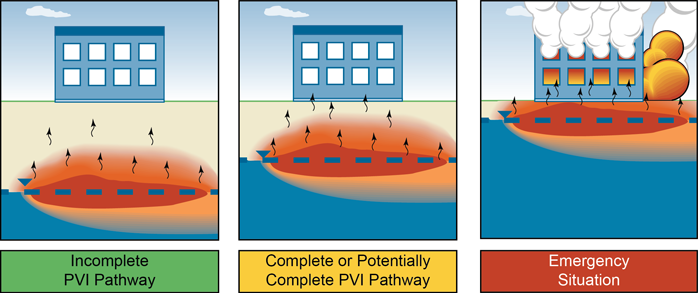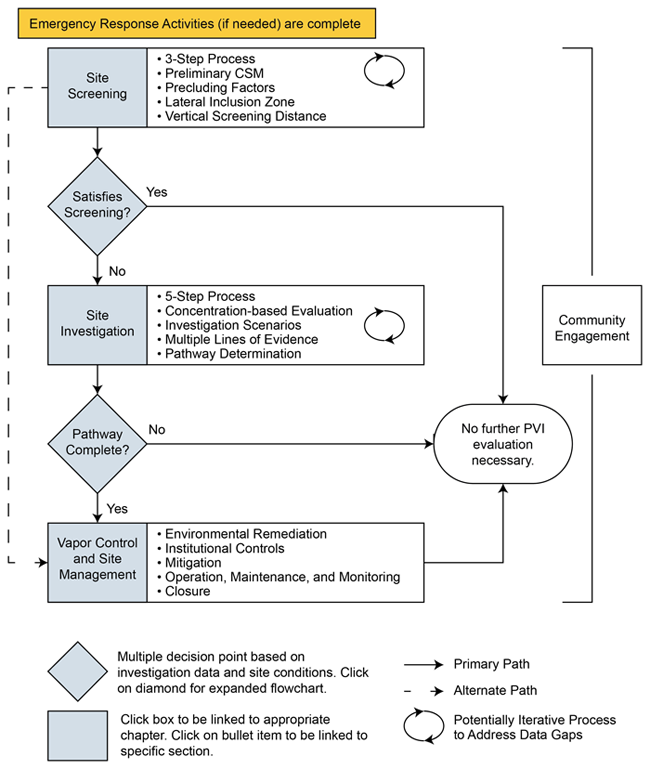
Chemical contaminants in soil and groundwater can volatilize into soil gas and migrate through unsaturated soils of the vadose zone. Vapor intrusion (VI) occurs when these vapors migrate upward into overlying buildings through cracks and gaps in the building floors, foundations, and utility conduits, and contaminate indoor air. If present at sufficiently high concentrations, these vapors may present a threat to the health and safety of building occupants.
Petroleum vapor intrusion (PVI) is a subset of VI and is the process by which volatile petroleum hydrocarbons (PHCs) released as vapors from light nonaqueous phase liquids (LNAPL), petroleum-contaminated soils, or petroleum-contaminated groundwater migrate through the vadose zone and into overlying buildings. Fortunately, in the case of PHC vapors, this migration is often limited by microorganisms that are normally present in soil. The organisms consume these chemicals, reducing them to nontoxic end products through the process of biodegradation. The extent and rate to which this natural biodegradation process occurs is strongly influenced by the concentration of the vapor source, the distance the vapors must travel through soil from the source to potential receptors, and the presence of oxygen (O2) in the subsurface environment between the source and potential receptors.
This PVI guidance document from the Interstate Technology and Regulatory Council (ITRC) builds on existing ITRC VI guidance (2007): Vapor Intrusion Pathway: A Practical Guideline (VI-1). This guidance document serves as a companion to the VI-1 document and also as a stand-alone resource that provides information and tools specific to PVI. In addition, this guidance is designed to complement the United States Environmental Protection Agency (USEPA) PVI guidance currently under development by the Office of Underground Storage Tanks (OUST). As currently drafted, the USEPA OUST PVI guidance is limited to underground storage tanks (USTs) regulated by Subtitle I of the Solid Waste Disposal Act, whereas this ITRC guidance document applies to various types of petroleum sites and multiple PHC compounds.
This PVI guidance is intended for sites involving VI of PHC compounds and not chlorinated volatile organic compounds (CVOCs) or other aerobically recalcitrant non-PHC compounds. Refer to Vapor Intrusion Pathway: A Practical Guideline (VI-1) for guidance on CVOCs and non-PHC compounds.
This guidance provides regulators and practitioners with consensus information based on empirical data and recent research to support PVI decision making under different regulatory frameworks. The PVI assessment strategy described in this guidance document enables confident decision making that protects human health for various types of petroleum sites and multiple PHC compounds. This guidance also provides a comprehensive methodology for screening, investigating, and managing potential PVI sites. The screening method is applicable for different types of petroleum sites with variability depending on whether the site is a smaller site, such as a UST or aboveground storage tank (AST) gas station, or a larger petroleum industrial site, such as a terminal, refinery, pipeline, or manufactured gas plant (MGP) site.
Figure 1-1 conceptually displays three possible outcomes for the PVI pathway.

PVI conceptual outcomes.
Emergency Situations
Contact first responders immediately if there are strong petroleum odors or evidence of, or reasons to suspect, combustible, explosive, or oxygen-deficient conditions inside the building.
This PVI guidance document applies only to the evaluation of the PVI pathway. Additional characterization and remediation of the PHC source, as well as evaluation of other exposure pathways and associated receptors, may be necessary under the rules and policies of the governing regulatory body and is not addressed in this document. For all pertinent regulations, please contact your local regulatory agency (see Appendix B for a list of PVI-related, regulatory contacts). Furthermore, ITRC has many applicable guidance documents to assist with remedial investigations and corrective actions (see the ITRC documents page).
Finally, this document does not cover emergency response actions related to PVI and assumes that all emergency situations have been handled prior to consulting this text. If strong petroleum odors are detected, or combustible, explosive, or oxygen-deficient conditions may exist inside a building, then first responders should be contacted immediately.
The primary audiences for this guidance document are regulators and private sector practitioners who evaluate and manage potential PVI sites. This document also provides responsible parties, site owners, managers, and other stakeholders with a basic understanding of the unique aspects of PVI. This guidance document explains the principles of PVI and assists with the following tasks:
The ITRC PVI Team developed this guidance document. The team included approximately 130 members from state and federal regulatory agencies, consultants, site owners (both private and public sectors), academia, and community stakeholders. Many of these team members are recognized experts in the fields of VI and PVI. See Appendix N for the complete PVI team roster.
State environmental regulatory agencies have consistently identified VI as a high priority. For sites contaminated with PHCs, many regulators and practitioners have noted uncertainty about how to best account for biodegradation of PHC vapors when evaluating PVI.
ITRC has developed this PVI guidance to provide a scientifically-based, consensus approach to explain the following key issues for managing PVI:
To support development of this document, the PVI Team conducted a survey of state environmental regulatory agencies to gain insight into the “state of the practice” for addressing potential PVI sites. Survey information was collected in the spring of 2012. Responses were provided from 49 states and the District of Columbia. Some of the key findings from the survey included:
Appendix A, PVI Survey – Summary of State Responses, provides a summary of the survey results.
A consistent approach to PVI that fits any regulatory framework and type of petroleum site is critical for confident decision making that protects human health. Figure 1-2, PVI strategy flowchart, presents a consistent, flexible approach. This strategy is a stepwise process, beginning with development of a preliminary conceptual site model (CSM) and site screening. This phase may be followed by a more detailed site investigation and refinement of the CSM or, if chosen, immediate vapor control. If the detailed investigation is chosen, depending on the outcome, site management specifically for PVI (such as vapor controls, long-term monitoring, and institutional controls) may be required. In addition, community engagement is a critical component of the strategy that should be considered throughout the PVI assessment process.
Iterations within each of the strategy phases may be warranted, and investigators must decide whether to continue data collection and interpretation within a particular phase or to proceed to the next phase. The following subsections highlight key aspects of the strategy and introduce the more detailed discussions in subsequent chapters.

PVI strategy flowchart.
Vertical Screening Distance
Vertical screening distance is the minimum thickness of soil between a petroleum vapor source and building foundation needed to effectively biodegrade hydrocarbons below a level of concern for PVI.
Site screening is the initial phase in the PVI assessment strategy for determining whether the PVI pathway is potentially complete or not. The PVI screening method detailed in Chapter 3, Site Screening, uses the concept of vertical screening distance to make this determination. The vertical screening distance is defined as the minimum thickness of soil between a petroleum vapor source and building foundation needed to effectively biodegrade hydrocarbons below a level of concern for PVI. This distance is based on empirical studies involving data collected at hundreds of petroleum release sites. The analysis of the data confirmed that all PHCs studied were aerobically biodegraded within the vertical screening distance. The vertical screening distance is determined based on whether the petroleum vapor source is LNAPL in the vadose soil or groundwater, or dissolved phase in groundwater.
Using this PVI screening method helps to minimize investigative efforts at sites where there is little risk of a complete PVI pathway. To use the PVI screening method based on the vertical separation distance, an investigator follows a stepwise procedure to construct a preliminary CSM with key site-specific information (see
Note that the application of this PVI screening approach is not based on chemical-specific screening levels. Other screening tools, such as attenuation factors or target concentrations for groundwater or soil gas, are concentration based and either do not account for biodegradation of PHCs or use a generic bioattenuation factor.
An outcome of the site screening process may be that additional investigation of the site is necessary to evaluate pathway completeness for PVI. Chapter 4, Site Investigation, and Chapter 5, Modeling, describe approaches and tools for conducting the site investigation phase of the PVI assessment strategy, along with specific issues related to investigation of PHCs.
If the site screening or site investigation steps determine that the pathway is complete or likely complete, then site management of the PVI pathway may be necessary. Management tools may include one or more options such as environmental remediation, institutional controls, and building mitigation. Regardless of the management tools used, the CSM should be refined and the PVI pathway reevaluated as conditions change or new information becomes available. Chapter 6, Vapor Control and Site Management, discusses these tools in detail, with specific attention to issues found at petroleum sites.